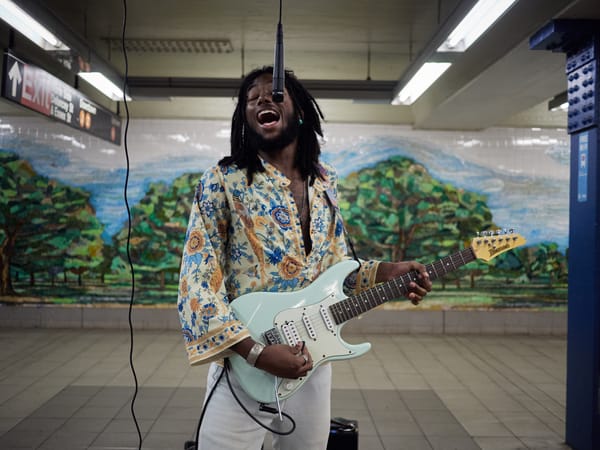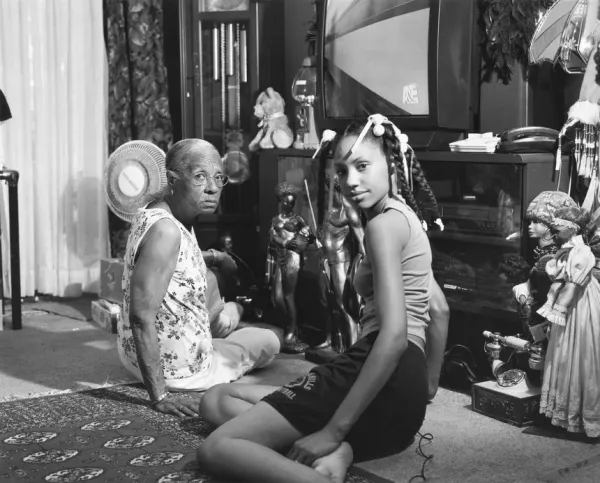Shifting the Gaze with Adama Jalloh

Photography has long been a tool for observation. But for many Black photographers, it becomes something more, a way to document truth, connect with community, and honour lived experience. Adama Jalloh is one of those artists.
Her work cuts through noise and spectacle. It captures people as they are. No pretence. No performance. Just presence.
This blog post explores Jalloh’s contribution to contemporary British photography. It looks at how her documentary style captures the beauty of everyday Black life. It also considers how her work embodies the Black gaze, offering a perspective that is personal, rooted, and full of care.
Introducing Adama Jalloh
Adama Jalloh is a British-Sierra Leonean photographer based in South London. She is best known for her powerful black and white portraiture, which often focuses on themes of identity, belonging, and community.
Her interest in photography began at school and developed further at university, where she studied at Arts University Bournemouth. Early on, she gravitated towards candid street photography. Over time, her style evolved into something slower and more intentional, a blend of documentary realism and quiet intimacy.
Jalloh’s work has been featured in publications like It’s Nice That, British Journal of Photography, and The Guardian. She has also collaborated with brands and organisations committed to more authentic forms of storytelling. Regardless of the platform, her focus stays the same. She wants to create images that are grounded in real connection.
Seeing the Everyday with Fresh Eyes
Jalloh’s photography often explores the rhythms of daily life. She captures moments that might seem ordinary at first, walking to school, sitting in a hair salon, leaning against a brick wall. But in her images, these moments feel elevated. They speak to memory, culture, and emotion.
She is particularly drawn to South London. Her portraits of friends, family, and local residents feel personal because they are. She photographs people she knows, or people who remind her of home. This gives her work a sense of trust and familiarity. Nothing is forced. Her subjects appear relaxed and in control of their image.
Her choice to work predominantly in black and white adds to this feeling. It removes distraction and allows the viewer to focus on texture, expression, and light. Her compositions are clean and direct. They highlight the strength and softness in her subjects without exaggeration.
These photographs do not shout. They don’t need to. Their power lies in their stillness.
Practising the Black Gaze
The Black gaze is about agency, who gets to look, who gets to be seen, and on what terms. Historically, Black lives have been photographed through a lens of distance, often shaped by curiosity, pity, or fear. The Black gaze pushes back. It centres self-representation and lived experience.
Adama Jalloh’s work embodies this gaze through intention and proximity. Her images do not objectify or over-explain. They simply witness. She captures people from within the culture, not from the outside looking in.
Her ability to connect is key. Jalloh often spends time getting to know her subjects before she takes a photo. This allows her to move past surface-level visuals. Her portraits feel honest because they are built on real relationships.
This approach extends to how she photographs public spaces. Whether it’s a market, a park, or a side street, Jalloh shows us these environments with familiarity. She reveals the everyday beauty of Black British life, not as something to be marvelled at, but as something that simply exists, and deserves to be seen.
Lessons from Adama Jalloh’s Practice
Jalloh’s work offers valuable lessons for anyone thinking about storytelling, representation, or creative process:
- Take your time. Her images are the result of slow looking and patient connection.
- Find beauty in the everyday. You don’t need drama to tell a powerful story.
- Be close to your subject. Her work is strongest when it reflects lived experience.
- Respect the person in the frame. Her portraits are built on trust, not performance.
- Honour your roots. South London is not just a backdrop in her work, it’s a source of strength.
Expanding the Lens
Adama Jalloh’s photography sits within a wider movement of Black British artists who are shifting the gaze and expanding visual culture.
She stands alongside creatives like:
- Ronan McKenzie, who blends fashion, curation, and portraiture to create deeply personal visual worlds
- Karis Beaumont, who uses vibrant colour and thoughtful composition to celebrate Black British identity
- Misan Harriman, whose global activism and portraiture centre Black voices and community resilience
Each artist has their own visual language. Together, they create a chorus of perspectives. They show that Black life cannot be reduced to a single narrative. It is layered, joyful, complex, and full of presence.
Conclusion
Adama Jalloh’s photography invites us to slow down and pay attention. Her portraits remind us that representation is not just about being seen, it is about being seen truthfully.
Through her camera, she documents Black British life with clarity and care. Her images offer no spectacle. Instead, they offer something rarer: quiet honesty, emotional depth, and deep respect.
By following her gaze, we begin to see everyday Black life not as background or context, but as the centre of the frame. Where it has always belonged.
Add your voice
Through The Black Gaze, we don’t just reflect the world, we reshape it. Your story matters. Share it. Honour it. Hold space for others. This is where truth lives and vision leads.
We invite Black photographers to contribute in two meaningful ways through story and image.






